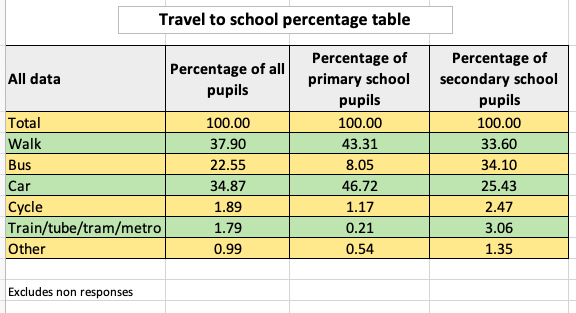Or search by topic
Number and algebra
Geometry and measure
Probability and statistics
Working mathematically
Advanced mathematics
For younger learners
Real Statistics



Census at School is an international project which collects data from children in participating countries all around the world, and makes it available for anyone to look at.
The table below contains data that was collected from the first questionnaires in Autumn 2000 and includes responses from children in England, Wales and Northern Ireland. It shows how pupils travel to school:

Which is the most popular way of getting to school for primary pupils?
How about for secondary pupils?
Can you think of any reasons why these might be different?
Which is the most common way of travelling to school overall?
Can you explain why this answer is different again?
What do you think the 'Other' category means?
What questions would you like to ask about the data?
Conduct your own survey on how everyone usually gets to school, perhaps in your class or year group.
Present your results in a table, chart or graph and please send it in to us.
Compare your findings to those in the table (you might want to look just at the primary school or secondary school data, depending on how old you are).
How are your results different?
Are there any similarities?
Can you think of any reasons why your findings might be different or similar?
You may also like
Florence Nightingale - the Compassionate Mathematician
Florence Nightingale may be well known for her role as a nurse, but she was also an excellent mathematician, collecting and analysing data to help improve hospital conditions.
Compare the Squares
In this problem you will do your own poll to find out whether your friends think two squares on a board are the same colour or not.
Birds in the Garden
This activity asks you to collect information about the birds you see in the garden. Are there patterns in the data or do the birds seem to visit randomly?

